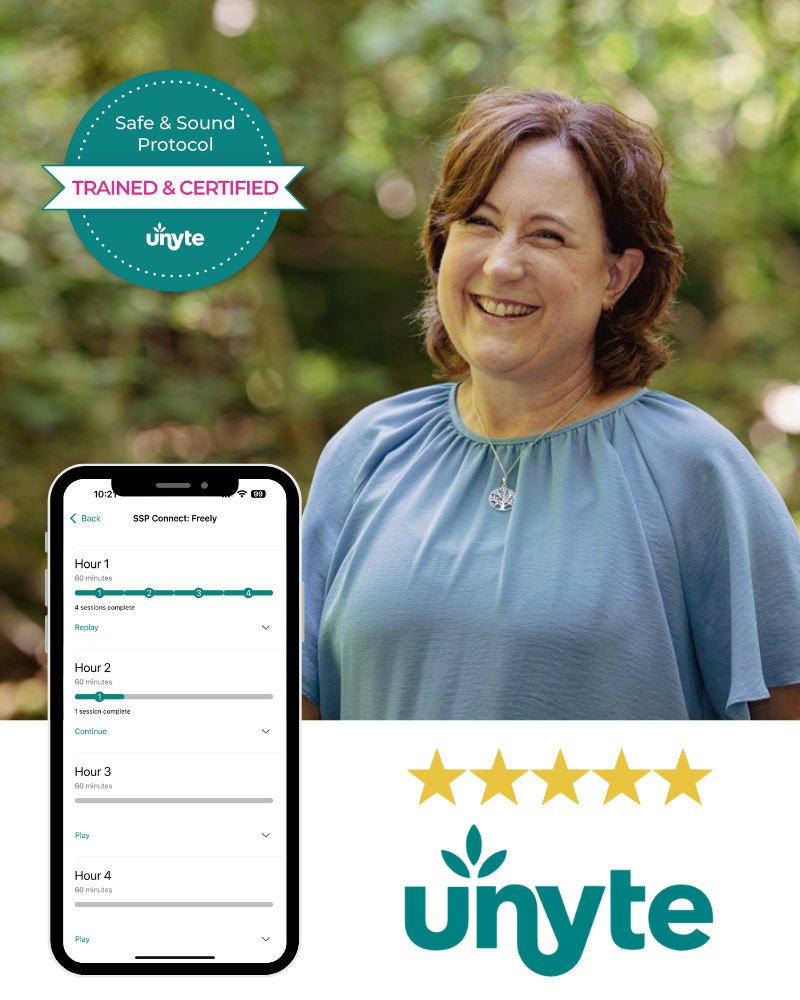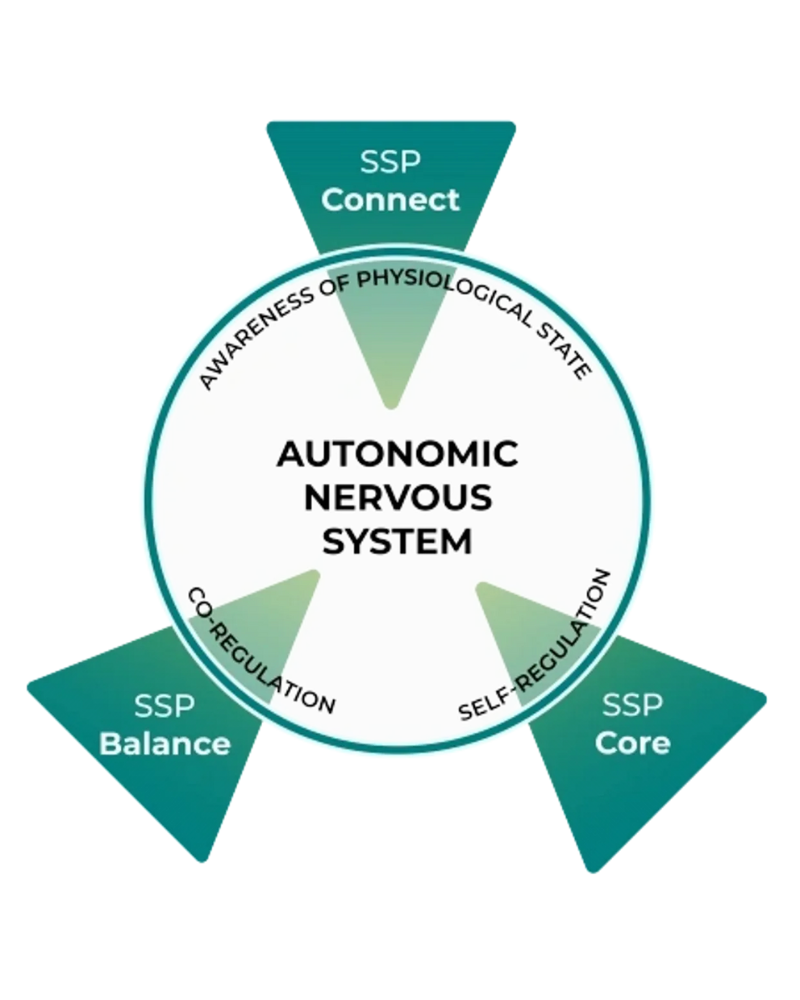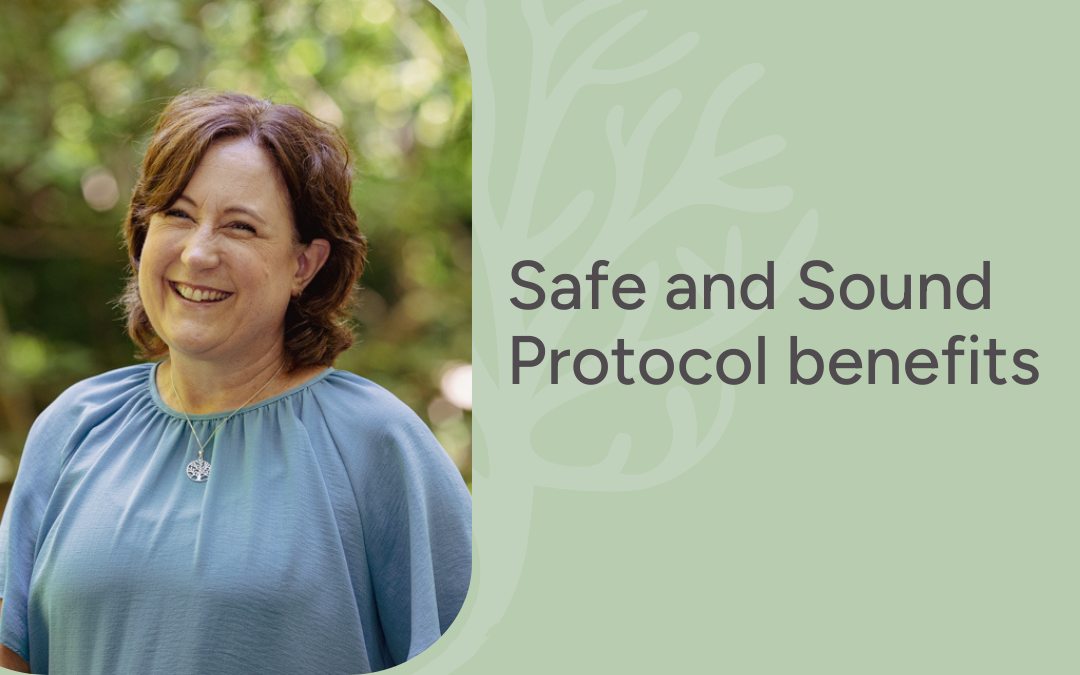Safe and Sound Protocol (SSP) Listening Therapy
Complex Connexions’ founder, Shelley Farnham, trained as a Safe and Sound Practitioner with Unyte after experiencing the challenges on her own parenting journey, feeling isolated and struggling to find support for my family. Shelley offers the Safe and Sound Protocol therapy for both adults and children.


What is the Safe and Sound Protocol?
The Safe and Sound Protocol is a music listening therapy, which stimulates the vagus nerve and helps the nervous system to become more regulated and less stuck in a fight, flight or freeze response.
SSP has been shown, among other things, to reduce feelings of stress, support auditory sensitivity and help the person to be able to interact with other people more easily.
It has been proven to address ADHD/Autistic traits such as attention difficulties, and cognitive skills like reading and writing, as it creates feelings of safety in the body which is the foundation for all learning.
Price
£75 for the intake session, followed by £175 per month for approximately 6 months.
How does SSP work?
Dr. Stephen Porges, the creator of The Polyvagal Theory, developed the Safe and Sound Protocol. His theory explains how the nervous system seeks safety through social connection and triggers a stress response when it perceives danger.
SSP works by using playlists, with specially filtered music, which repattern the tiny middle ear stapedius muscles, and also the brain receptors, to be more able to recognise and respond to signals of safety.
This means that the listener’s nervous system becomes more regulated and so they are able to engage more easily with other people, they can pay attention and focus as they’re not constantly on alert, they are not as sensitive to sound and they become less anxious.
What to expect
After a free initial chat you’ll book your intake session, where you’ll pick from several music playlists, to ensure you feel comfortable with the music, and you’ll then begin with the listening at home.
The connection with the programme facilitator, Shelley, is a vital part of this process and so apart from an initial session, lasting around 60 minutes, a weekly check-in is part of the process as well.
The programme lasts approximately 6 months (depending on individual responses) and the filtered music changes the ear and brain responses to safe sound frequencies, and so regulates the nervous system over this time.
The SSP can be done in-person, remotely or as a hybrid version.
The benefits of the Safe and Sound Protocol

SSP supports with anxiety, sound sensitivities, sound processing difficulties, social engagement, traits of ADHD/Autism such as attention, impulsivity and emotion regulation

SSP helps people with a dysregulated nervous system living in fight, flight or freeze to have more regulation and feel more calm and connection, with themselves and others
Proven results
Clinical trials reported by Uynte show that SSP leads to significant improvements in anxiety, depression, and trauma-related symptoms.

85% of individuals who undergo SSP report a reduction in anxiety symptoms.

81% of individuals who undergo SSP report a reduction in symptoms of depression.

87% of individuals who undergo SSP report a reduction in trauma-related symptoms.

84% of caregivers of children who undergo SSP report a reduction in psychosocial challenges.

Who you'll be working with

When you start the Safe and Sound Protocol (SSP) with Complex Connexions, you’ll be working with Shelley Farnham, an experienced Safe and Sound Protocol provider and the founder of Complex Connexions.
With specialist training in neurodevelopment, emotional regulation, and auditory intervention therapies, Shelley is dedicated to helping individuals and families experience the benefits of SSP in a safe, supportive environment.
As both a neurodivergent parent and an experienced educator, she understands the unique challenges that can come with sensory processing, emotional regulation, and nervous system resilience. Her approach is rooted in connection, understanding, and practical strategies, ensuring that every client receives the tailored support they need to get the most out of SSP.
Safe and Sound Protocol process

The first step is to book a free initial chat with Shelley so we can discuss if SSP is the best solution for you based on your needs and she can answer any questions you have. Book your free initial chat here
The 60-minute intake session is where we will chat about your nervous system, choose the playlist that feels good for you and make a plan for listening, going with what works with your schedule.
We’ll have a weekly check-in to chat what you’ve observed about your nervous system response to the music, how you’re feeling and any changes you’ve noticed.
Throughout the programme you will work through 3 pathways of music: Connect, Core and Balance. Learn more about each of the pathways here
The programme is expected to take around 6 months, depending on personal responses during that time. With the physical changes and the understanding, you are also able to self-regulate and co-regulate more easily.
Safe and Sound Protocol process

The first step is to book a free initial chat with me, so we can discuss if SSP is the best solution for you based on your needs and I can answer any questions you have. Book your free initial chat here

The 60-minute intake session is where we will chat about your nervous system, choose the playlist that feels good for you and make a plan for listening, going with what works with your schedule.

We’ll have a weekly check-in to chat what you’ve observed about your nervous system response to the music, how you’re feeling and any changes you’ve noticed.

Throughout the programme you will work through 3 pathways of music: Connect, Core and Balance. Learn more about each of the pathways here

The programme is expected to take around 6 months, depending on personal responses during that time. With the physical changes and the understanding, you are also able to self-regulate and co-regulate more easily.
Testimonials

Safe and Sound Protocol pathways

The Safe and Sound Protocol is designed as a three-phase listening journey, each stage building upon the last to support nervous system regulation. These phases, Connect, Core, and Balance, work together to create a gradual and effective process for improving emotional and physiological resilience.
SSP Connect: This is the first set of music you will listen to as part of SSP. It is unfiltered music, helping you to develop familiarity with the music, a routine of listening and more awareness around your physiological state.
SSP Core: Once you have completed the SSP Connect playlist you will move on to SSP Core. This is the filtered music that repatterns your middle-ear muscles and brain, leading to improved self-regulation. Co-regulation with the facilitator is crucial for self-regulation here.
SSP Balance: After the Core, you move on to the Balance listening. This is lightly filtered music which continues the process started with the Core, and helps your nervous system to continue to process and find more regulation.
I am pleased to now also offer Dr Porges’ new Rest and Restore Protocol (RRP) programme.
Safe and Sound Protocol FAQs
How long does SSP take to do?
SSP is tailored to each person’s nervous system responses, so the time can vary, but on average it will be around 6 months. We take the process slow and steady to create feelings of safety.
Who is SSP for?
SSP is for adults and children and will address concerns like anxiety, sound sensitivities, struggles with relationships, attention and focus difficulties – our nervous system affects ALL aspects of our life and so everything is influenced if it is dysregulated. When we feel safe and settled, we are much more able to engage in life, in harmony with ourselves and others.
What are the side effects of SSP?
SSP is a gentle intervention and because we work closely to engage but not overwhelm the nervous system, we do not envisage any big negative side effects. There may be some interesting reactions that we take note of as we progress but we always work on the principle of ‘less is more’ and keep you feeling safe and secure whilst helping your nervous system to grow capacity.
Why should I choose SSP?
SSP is a gentle way to bring nervous system regulation through the music, and as part of the process, also learning about your nervous system responses and also how to send simple messages of safety to your brain through your body. When we know our nervous system and are connected to our brains and bodies, it means we are much more connected to ourselves and to others.
Can a parent and child do SSP together?
Yes they can – the parent would start the programme so that they get some way into their regulation journey before the child begins their programme so that they are able to be a good co-regulator. The cost for the parent is as detailed above, but the child’s fees are reduced by 50%.
Can I do SSP alongside other therapy?
How much does SSP cost?
It is £75 for the 1-hour intake session and then £175 per month thereafter, which includes access to the music programme as well as weekly check-ins and between-session messaging access too. Although you listen to the music yourself, our SSP practitioner, Shelley, is always there for any questions or concerns you have.
What are the benefits of SSP?
SSP changes how our ears hear sounds and how our brain interprets and responds to sounds. When we are in a state of fight, flight or freeze this is inaccurate and so our nervous system cannot hear any sounds as safe and comforting – everything is a threat. SSP repatterns the middle ear muscles, the sound interpretation and soothes the nervous system, which means that we are more regulated and can engage with other people more easily and feel safe in the world.
Does SSP have to be done in person?
SSP can be done in-person, online (virtually), or as a hybrid model, with the same benefits across all formats. At Complex Connexions, we provide all three options to ensure accessibility and convenience for individuals and families. If you do want to do the in-person option, we are based in Newcastle upon Tyne, UK. You do most of the listening in your own time, and we’ll meet to reflect, to help you learn more about your nervous system responses and to explore simple body/brain strategies that you can use generally for regulation or in especially difficult moments.
How does SSP work for a child/teen?
We can do the meet-ups with parents and they can oversee the music listening with their child/teen if that works out best, or we can meet with the child/teen directly. For kids, the parent’s involvement is crucial, as they will need to create time and space at home to facilitate the listening sessions effectively.
What does the SSP music sound like?
The SSP music is carefully curated and filtered using a scientifically developed algorithm backed by decades of research. With playlists ranging from classical to contemporary, both lyrical and non-lyrical, the music is designed to engage the nervous system and support regulation. As you progress through SSP, the filtering increases, which may change how the music sounds. This gradual process allows your nervous system to adapt, making the experience soothing and supportive.
Safe and Sound Protocol FAQs
How long does SSP take to do?
SSP is tailored to each person’s nervous system responses, so the time can vary, but on average it will be around 6 months. We take the process slow and steady to create feelings of safety.
Who is SSP for?
SSP is for adults and children and will address concerns like anxiety, sound sensitivities, struggles with relationships, attention and focus difficulties – our nervous system affects ALL aspects of our life and so everything is influenced if it is dysregulated. When we feel safe and settled, we are much more able to engage in life, in harmony with ourselves and others.
How much does SSP cost?
It is £75 for the 1-hour intake session and then £175 per month thereafter, which includes access to the music programme as well as weekly check-ins and between-session messaging access too. Although you listen to the music yourself, I’m always there for any questions or concerns you have.
What are the benefits of SSP?
SSP changes how our ears hear sounds and how our brain interprets and responds to sounds. When we are in a state of fight, flight or freeze this is inaccurate and so our nervous system cannot hear any sounds as safe and comforting – everything is a threat. SSP repatterns the middle ear muscles, the sound interpretation and soothes the nervous system, which means that we are more regulated and can engage with other people more easily and feel safe in the world.
What are the side effects of SSP?
SSP is a gentle intervention, and because we work closely to engage but not overwhelm the nervous system, we do not envisage any big negative side effects. There may be some interesting reactions that we take note of as we progress, but we always work on the principle of ‘less is more’ and keep you feeling safe and secure whilst helping your nervous system to grow capacity.
Does SSP have to be done in person?
SSP can be done in-person, online (virtually), or as a hybrid model, with the same benefits across all formats. At Complex Connexions, we provide all three options to ensure accessibility and convenience for individuals and families. If you do want to do the in-person option, we are based in Newcastle upon Tyne, UK. You do most of the listening in your own time, and we’ll meet to reflect, to help you learn more about your nervous system responses and to explore simple body/brain strategies that you can use generally for regulation or in especially difficult moments.
Why should I choose SSP?
SSP is a gentle way to bring nervous system regulation through the music, and as part of the process, also learning about your nervous system responses and also how to send simple messages of safety to your brain through your body. When we know our nervous system and are connected to our brains and bodies, it means we are much more connected to ourselves and to others.
What does the SSP music sound like?
The SSP music is carefully curated and filtered using a scientifically developed algorithm backed by decades of research. With playlists ranging from classical to contemporary, both lyrical and non-lyrical, the music is designed to engage the nervous system and support regulation. As you progress through SSP, the filtering increases, which may change how the music sounds. This gradual process allows your nervous system to adapt, making the experience soothing and supportive.
How does SSP work for a child/teen?
We can do the meet-ups with parents and they can oversee the music listening with their child/teen if that works out best, or we can meet with the child/teen directly. For kids, the parent’s involvement is crucial, as they will need to create time and space at home to facilitate the listening sessions effectively.
Can a parent and child do SSP together?
Yes they can – the parent would start the programme so that they get some way into their regulation journey before the child begins their programme so that they are able to be a good co-regulator. The cost for the parent is as detailed above, but the child’s fees are reduced by 50%.
Can I do SSP alongside other therapy?
Not sure if this is the right next step?
If you’re not sure if this would be a good fit for you or your child/ teen, you can book a 30-minute, no-obligation chat with our founder, Shelley where she can tell you more and answer any questions you have.
You can then make up your own mind on what you want to do next, with no pressure from us.


Safe and Sound Protocol Therapy for kids
The SSP listening creates physical changes, so that your child or teen’s ears are able to hear, and their brain is able to process, more of the safe sounds, like your voice. This helps their nervous system to be more regulated and supports them in recognising feelings and developing emotion regulation skills.

Safe and Sound Protocol therapy for adults
The music listening therapy, as well as the 1-2-1 sessions, helps you to get to know yourself and understand your nervous system responses better – this helps you to be less critical and have more self-compassion, thereby developing your emotion regulation skills.

Want to learn more?
Watch Shelley’s introduction to the Safe and Sound Protocol to learn more about SSP – how it works, who it’s for, how long the programme is and how to sign up.
Check out our latest SSP blogs
5 Key Benefits of The Safe and Sound Protocol
What is the Safe and Sound Protocol (SSP)? The Safe and Sound Protocol is a gentle, music listening therapy, that makes physical changes to the way our ears hear sounds, and our brain processes those sounds, and also stimulates the Vagus Nerve, meaning that our...

Book your free, 30 minute initial SSP chat with Shelley
✓ Confidential and supportive environment
✓ Personalised guidance tailored to your needs
✓ No commitment
✓ 100% free, no payment required
Shelley’s approach is both compassionate and learned, and I don’t know how I would have navigated my daughters autism diagnosis without her. Absolutely Amazing.
Book your free, 30 minute initial SSP chat with Shelley
✓ Confidential and supportive environment
✓ Personalised guidance tailored to your needs
✓ No commitment
✓ 100% free, no payment required
Shelley’s approach is both compassionate and learned, and I don’t know how I would have navigated my daughters autism diagnosis without her. Absolutely Amazing.

